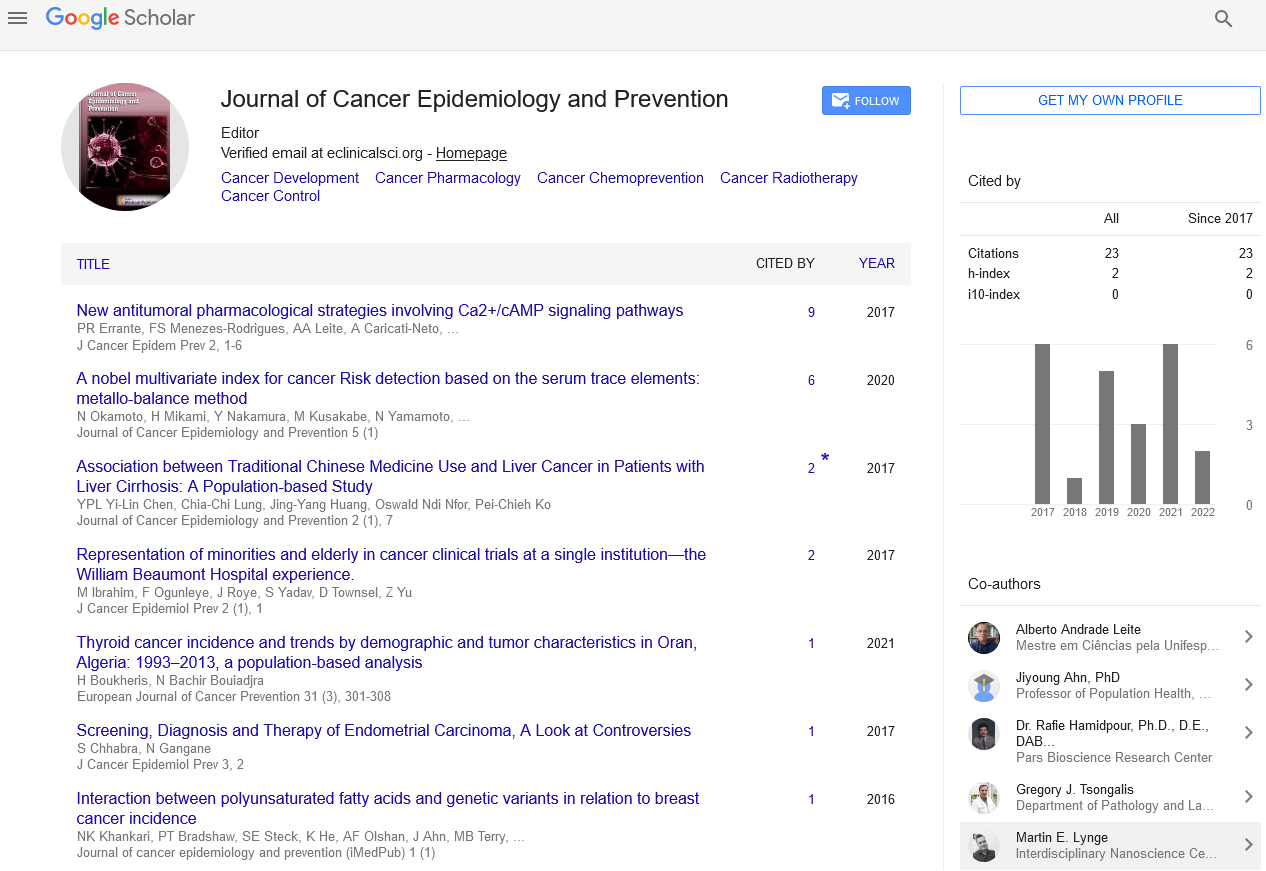Short Communication - (2024) Volume 9, Issue 2
Understanding Cancer Mortality: A Comprehensive Analysis
Alexander Hemander*
Department of Cancer Control, National Cancer Institute, USA
*Correspondence:
Alexander Hemander,
Department of Cancer Control, National Cancer Institute,
USA,
Email:
Received: 29-May-2024, Manuscript No. IPJCEP-24-20843;
Editor assigned: 31-May-2024, Pre QC No. IPJCEP-24-20843 (PQ);
Reviewed: 14-Jun-2024, QC No. IPJCEP-24-20843;
Revised: 19-Jun-2024, Manuscript No. IPJCEP-24-20843 (R);
Published:
26-Jun-2024, DOI: 10.36648/IPJCEP.9.2.11
Introduction
Cancer, a multifaceted group of diseases characterized by
abnormal cell growth, remains one of the most significant
challenges to global health. Its impact is profound, touching
millions of lives each year with a spectrum of outcomes ranging
from survival to mortality. In this comprehensive article, we
delve into the complexities of cancer mortality, exploring its
patterns, contributing factors, advancements in treatment,
and public health strategies aimed at reducing its toll on
humanity. Cancer mortality refers to deaths attributed directly
to cancerous tumours or related complications. Understanding
the dynamics of cancer mortality involves examining various
aspects. Cancer is a leading cause of death worldwide,
responsible for approximately 10 million deaths annually. The
burden is distributed unevenly across regions, with higher
incidence and mortality rates in low- and middle-income
countries due to factors such as limited access to healthcare,
late-stage diagnosis, and inadequate treatment options. There
are over 100 types of cancer, each with its unique characteristics
and mortality rates. Common cancers contributing significantly
to mortality include lung, colorectal, breast, and prostate
cancers, among others [1,2]. Mortality rates for certain cancers
have declined over recent decades due to advances in early
detection, treatment modalities, and public health initiatives
promoting lifestyle changes and cancer prevention.
Description
Several factors contribute to cancer mortality, shaping both
individual outcomes and broader epidemiological trends. Timely
detection through screening programs (e.g., mammography for
breast cancer, colonoscopy for colorectal cancer) can significantly
improve survival rates by enabling early intervention when
the disease is more treatable. Advances in cancer treatment,
including chemotherapy, radiation therapy, targeted therapies,
and immunotherapy, have transformed outcomes for many
cancer types, prolonging survival and reducing mortality rates.
Lifestyle factors such as tobacco use, unhealthy diet, physical
inactivity, and environmental exposures (e.g., carcinogens)
contribute significantly to cancer risk and mortality. Efforts
to mitigate these factors through public health campaigns
and policy interventions can reduce cancer incidence and
mortality. Disparities in healthcare access and quality impact
cancer mortality rates, with marginalized populations often
experiencing poorer outcomes due to barriers in accessing
timely diagnosis and effective treatment. Genetic predisposition
and biological characteristics of tumours influence treatment
response and overall prognosis, highlighting the importance of
personalized medicine approaches in cancer care. The burden
of cancer mortality varies significantly across regions and
countries, influenced by socioeconomic factors, healthcare
infrastructure, and cultural practices [3,4]. Generally have lower
cancer mortality rates due to better healthcare access, early
detection programs, and advanced treatment options.
Conclusion
However, specific cancer types may still pose significant
challenges. Face higher cancer mortality rates, often due
to late-stage diagnosis, limited treatment facilities, and
insufficient resources for comprehensive cancer care. Efforts to
improve healthcare infrastructure and implement cost-effective
interventions are critical in reducing disparities. Recent decades
have witnessed remarkable progress in cancer treatment
modalities, contributing to improved survival and quality of
life for patients. Tailoring treatment based on genetic and
molecular characteristics of tumours allows for more targeted
therapies, enhancing treatment efficacy and reducing side
effects. Harnessing the body’s immune system to target cancer
cells has revolutionized treatment for certain cancers, offering
new hope for patients with previously untreatable malignancies.
Innovations in surgical techniques and radiation delivery have
improved outcomes, enabling more precise tumour removal
and reduced damage to surrounding healthy tissues.
Acknowledgement
None.
Conflict Of Interest
The author’s declared that they have no conflict of interest.
References
- Matasar MJ, Zelenetz AD (2008) Overview of lymphoma diagnosis and management. Radiol Clin North Am. 46(2):175-98.
[Crossref] [Google Scholar]
- Grommes C, DeAngelis LM (2017) Primary CNS lymphoma. J Clin Oncol. 35(21):2410-2418.
[Crossref] [Google Scholar]
- Minson A, Dickinson A (2021) Glofitamab CD20-TCB bispecific antibody. Leuk Lymphoma. 62(13):3098-3108.
[Crossref] [Google Scholar]
- Shah NN, Fry TJ (2019) Mechanisms of resistance to CAR T cell therapy. Nat Rev Clin Oncol. 16(6):372-385.
[Crossref] [Google Scholar]
Citation: Hemander A (2024) Understanding Cancer Mortality: A Comprehensive Analysis. J Cancer Epidemiol Prev. 9:11.
Copyright: © 2024 Hemander A. This is an open-access article distributed under the terms of the Creative Commons Attribution License, which permits unrestricted use, distribution, and reproduction in any medium, provided the original author and source are credited.

